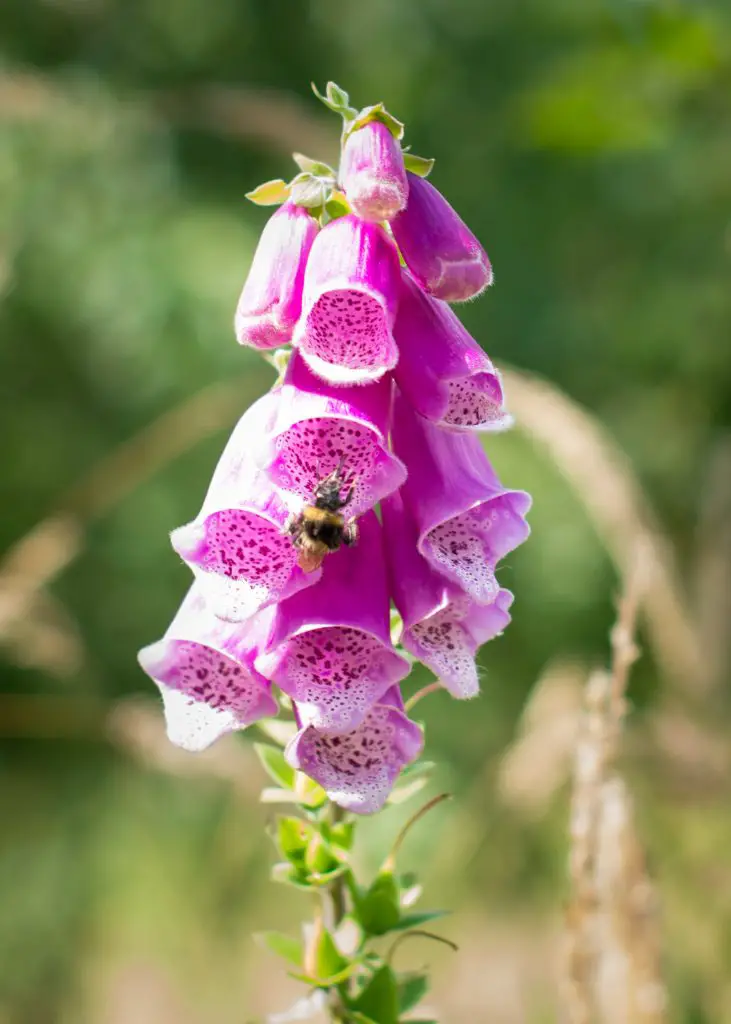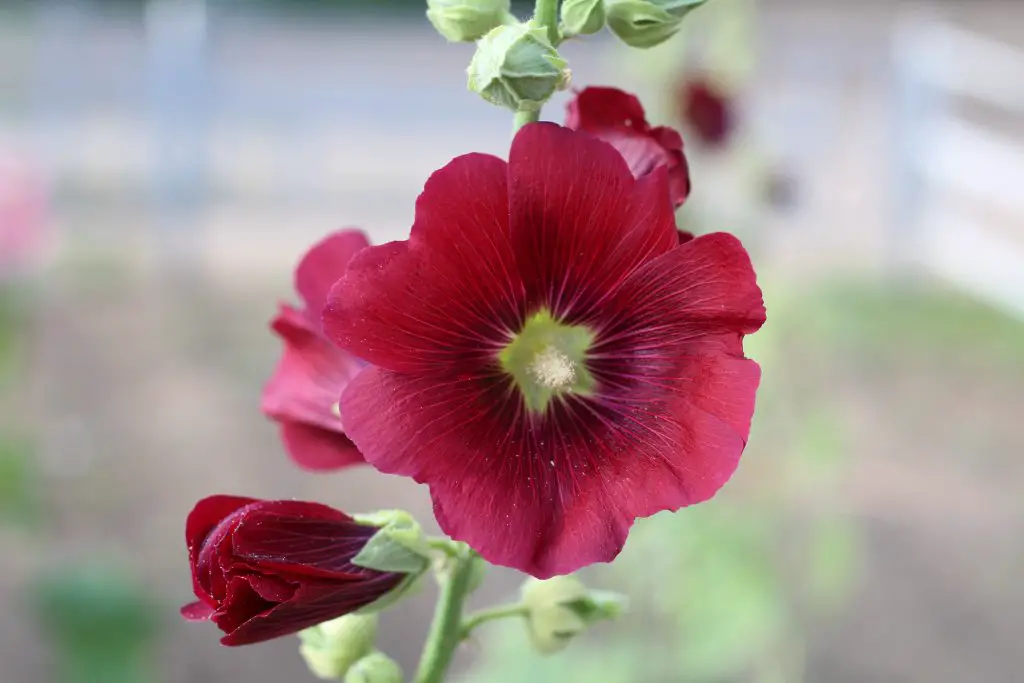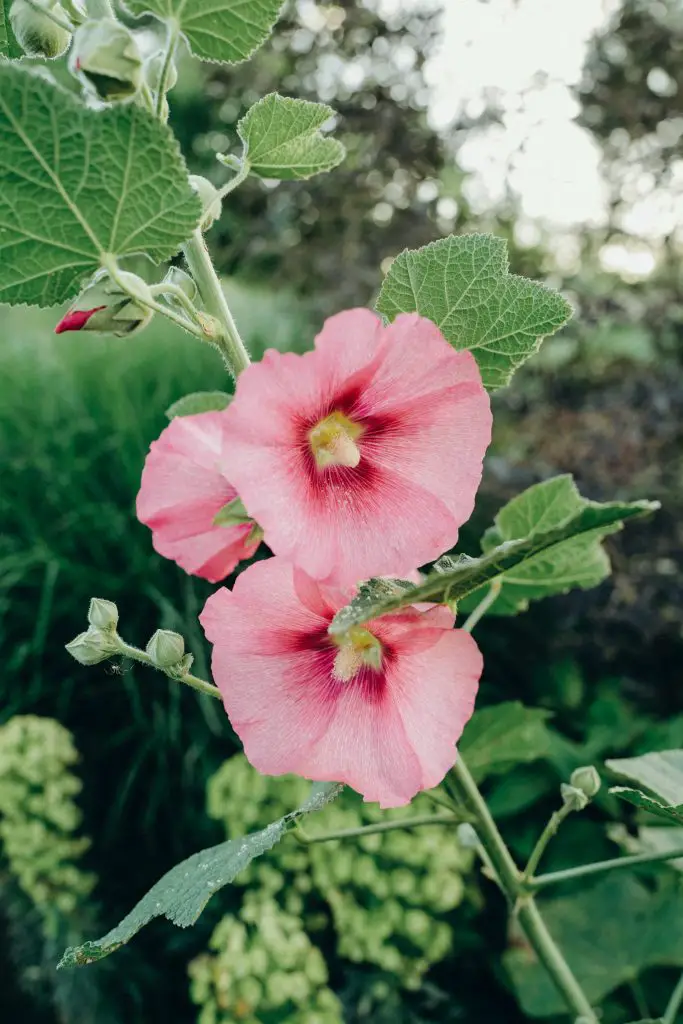What’s The Difference Between Foxgloves and Hollyhocks? Hollyhocks and foxgloves are among the most beautiful and striking cottage garden plants that are available. Both plants produce tall spires at reach a height of around 4 to 6 feet and have flowers running up and down the spires. Given the obvious similarity are they actually different plants or the same plant by different name?
Foxgloves and hollyhocks are distinct and separate species that are not closely related despite there being several physical similarities between the plants. The most common form of both plants is biennial which means that they flower in the second season before dying back, however, there are also varieties that are perennial and annual. The most distinctive difference between the plants is the shape of the flowers. Foxgloves produce a bell shaped flower that faces downward whereas hollyhocks produce open flowers that face outward from the main stem.
The other significant difference that is extremely noteworthy is that foxgloves are well known to be highly poisonous plants to humans and animals. They produce a range of symptoms if consumed that in some cases can lead to death. Whereas hollyhocks will cause mild dermatitis and skin irritations but are not nearly as poisonous as foxgloves.

About Foxgloves
As mentioned above foxgloves are a popular cottage garden plant despite their toxicity. There are approximately 20 different species of foxgloves which fall into the genus known as digitalis. This group of plants originated in Europe Western Asia and in northern parts of Africa.
The plants produce a tall spike that has flowers that range in colour from white, yellow, pink, to purple. Even though the plant is toxicity it is also known as being useful in the production of medicines for people with heart issues.
The most well-known variety of foxgloves is the White Dalmatian which is also known as the common foxglove. The plant produces white flowers with dark purple spots on the inside of the flower. However, there are many other varieties foxgloves available, to see a wide variety of these try visiting Gardenia.net. This site has a lot of detail and will allow you to easily compare common varieties.

About Hollyhocks
Hollyhocks are also native to Europe and Asia and grown widely in cottage gardens, though they are generally not as popular as foxgloves. The hollyhocks have a wider range of colours than the foxgloves that extends two reds and dark purples as well as whites pinks and yellows.
There is also greater variation in the type of flower that appears on the stalks with double and single petal flowers being available. Additionally, there are varieties that are annual perennial and biennial which means that there is generally greater variety in the types of plants that you can grow from this genus compared to foxgloves. They are also not nearly as toxic as foxgloves and are usually taller most commonly 5 to 6 ft tall. There are some varieties of foxgloves that reach this height however not all of them do.
However, the one disadvantage that these plants have compared to foxglove is that they are not as deer resistant largely because they are not as toxic. As such if you live in a location that has a large deer population it is advisable to plant the foxgloves in the outer part of the garden which are more exposed as they will not be eaten. To read more about how to protect your garden from Deer click here.
How To Grow Foxgloves And Hollyhocks
Despite the fact that both of these plants come from distinctly different plant families they require similar conditions to grow. Both plants can be grown from seed which is readily available from your local garden center or a retailer like seeds now.
The best time to start the plants off is in early to mid-spring when the weather is starting to warm up. To sow the seeds start by filling a seed tray with a good quality seed raising mix and then plant the seeds at a depth of 0.5 inches in the case of hollyhocks. For foxgloves the seed should be sprinkled across the surface and pressed gently into the seed raising mix as they require light to germinate.
The plants will typically germinate after 7 to 14 days provided that the temperatures are sufficiently warm during this period when the plants are in the seed tray it is important to ensure that they are watered regularly so that the soil remains moist.
The seedlings will typically need to spend 6 to 8 weeks in the seed tray depending upon the growing conditions. Once the seedlings are large enough they can then be planted out into the garden at a spacing of 1 to 2 feet (30 to 60cm).
In terms of growing conditions, both plants prefer a sunny location but they will tolerate some degree of shade. But the more shade the fewer flowers that the plant will produce. In terms of soil conditions both plants ideally should be planted into a rich moist soil with plenty of nutrients. To increase the level of nutrition in the soil it is advisable to dig in a bag of compost before planting the seedlings.
Once the seedlings are in the ground it is advisable to mulch them and apply some snail bait to ensure that they are not attacked by any slugs or snails. To ensure that they remain healthy it is important to water them regularly particularly when the weather is dry.
If you live in a windy location it may also be necessary to provide some support. This can be done by using stakes however they can detract from the appearance of the garden. To avoid this you can use wire supports that curve around the plant approximately half way up. These supports can be made at home by taking a length of wire and bending it around a tree to create a u shape which is used to cradle the storks.

To enable the u-shaped to sit horizontally with the soils’ surface the ends of the wires should be bent down at a 90 degree angle so that they can be pushed into the soil to create the support.
If you are growing biennial varieties they will not produce a flower store until the following year and they will remain a small shrub for the entire first year. Once these varieties produce flowers they will die back in the second year however both the hollyhock and the foxgloves tend to self seed very readily which means that it is highly likely that you will start to see new plants popping up the following season.
However, if you are growing a perennial variety such as Blacknight which is a popular hollyhock the flower storks should be removed after flowering is completed.
I hope you found this article useful and have great success growing foxgloves and hollyhocks in your own garden. If you have any questions or comments please leave them in the section below.
Relevant Articles
Are Hollyhocks Poisonous? Can I touch Them?
Are Foxgloves Poisonous? Can You Touch Them?
How To Prevent Weeds From Growing
Are Zinnia And Dahlias The Same Plant? What’s The Difference?

